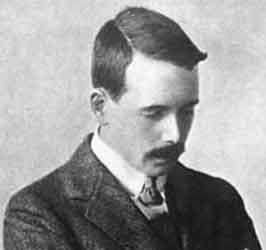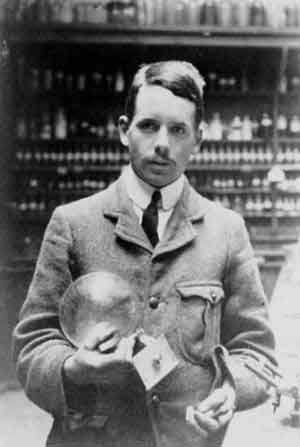.
Henry Gwyn Jeffreys Moseley

Henry Gwyn Jeffreys Moseley (November 23, 1887 – August 10, 1915) was an English physicist. His main contributions to science were the quantitative justification of the previously empirical concept of atomic number, and Moseley's law. This law advanced chemistry by immediately sorting the elements of the periodic table in a more logical order. It also advanced basic physics by providing independent support for the Bohr model of the Rutherford/Antonius Van den Broek nuclear atom containing positive nuclear charge equal to atomic number.
Biography
Moseley was born in Weymouth, Dorset, on the south west coast of England in 1887. His father Henry Nottidge Moseley was a naturalist, a Professor of Anatomy and physiology at Oxford and a member of the Challenger Expedition. [1] He attended Eton College on a King's scholarship [2]. In 1906, he entered Trinity College of the University of Oxford, and on graduation from that institution in 1910 went to Manchester University to work with Ernest Rutherford. During his first year at Manchester, he had a full teaching load, but after a year he was relieved of his teaching duties and began full-time research.
In 1913, by using x-ray spectra obtained by diffraction in crystals, he found a systematic relation between wavelength and atomic number, Moseley's law. Previous to this, atomic numbers or elemental numbers had been thought of as a semi-arbitrary sequential ordering-number, based on sequence of atomic masses, but altered when necessary (for example, by Dimitri Mendeleev) to put an element in the appropriate place in the periodic table. For example, cobalt and nickel had been assigned atomic numbers of 27 and 28, respectively, based on their chemical properties, since they have nearly identical atomic mass (in fact, cobalt's atomic mass is larger than nickel's, which would have reversed them had they been placed in the periodic table strictly according to this criterion). Moseley's experiments were able to show directly that cobalt and nickel have clearly differing atomic numbers of 27 and 28, and are correctly placed in the periodic table by an objective measure. Moseley's discovery thus showed that atomic numbers were not arbitrary, but have an experimentally measurable basis.
In addition, Moseley showed that there were gaps in the atomic number sequence at numbers 43, 61, 72, and 75. These spaces are now known, respectively, to be the places of the radioactive very rare elements technetium and promethium, and the last two discovered naturally-occurring stable elements hafnium (discovered 1923) and rhenium (discovered 1925). None were known in Moseley's time. Mendeleev had previously predicted technetium, and Bohuslav Brauner had previously predicted promethium; Moseley confirmed their predictions, predicted the two additional undiscovered elements, and argued that there were no other gaps in the periodic table between aluminum and gold.
This last matter had been an issue, particularly with the rare earths. Moseley was able to order, and argue for, the separate existence of each of the 14 (and importantly, no more and no less) so-called lanthanide series of rare-earth elements, which follow lanthanum. The number of lanthanides was an issue very far from being settled chemically by the science of that time, which could not yet provide pure samples of all the rare earth salts, and in some cases was chemically unable to tell mixtures of two very similar elements from pure materials. Moseley's instrument was able to sort out these problems, some of which had occupied chemists for years, almost immediately.
In 1914, Moseley resigned at Manchester to return to Oxford to pursue his research, but when World War I broke out, he turned down a job offer and enlisted in the Royal Engineers. He fought at Gallipoli, where he was killed in action by a sniper in 1915, shot through the head while in the act of telephoning an order. Many have since speculated that he would have won the Nobel Prize, but was unable to because it is only awarded to the living. It is speculated that because of Moseley's death in the War that the British and other world governments began a policy of no longer allowing their scientists to enlist for combat.
Only twenty-seven years old at death, Moseley could in many scientists' opinions have contributed much to the knowledge of atomic structure had he lived. As Niels Bohr once said in 1962, "You see actually the Rutherford work [the nuclear atom] was not taken seriously. We cannot understand today, but it was not taken seriously at all. There was no mention of it any place. The great change came from Moseley."

Contribution to our understanding
Previous to Moseley and his law, atomic numbers had been thought of as a semi-arbitrary ordering number, vaguely increasing with atomic weight but not strictly defined by it. Moseley's discovery showed that atomic numbers were not arbitrary but have a physical basis. He redefined the idea of atomic numbers from its previous status as an around-about approximate numerical tag to help sorting, i.e. in the periodic table, into a real and objective whole-number quantity which was experimentally directly measurable. Furthermore, as noted by Bohr, Moseley's law provided a reasonably complete experimental set of data supporting the (at that time new from 1911) Ernest Rutherford/Antonius Van den Broek concept of the atom, in which atomic number is understood as representing physically exactly the number of positive charges (protons) in a central atomic nucleus (Moseley mentions these two scientists in his paper, but does not actually mention Bohr). A simple modification of Rydberg and Bohr's formula was found to give Moseley's empirically-derived law for measurement of atomic number.
Use of X-ray spectrometer
X-ray spectrometers as Moseley knew them worked as follows: A glass-bulb electron tube similar to that held by Moseley in the photo above, was used. Inside the evacuated tube, electrons were fired at a substance (i.e. a sample of pure element in Moseley's work), causing ionisation of a core electron. Decay of the core hole then led to emission of x-rays which were led out of the tube in a semi-beam, through an opening in the external X-ray shielding, then diffracted by a standard salt crystal, with angular results read out as lines by exposure of an X-ray film plate fixed outside the vacuum tube, at a known distance. Application of Bragg's law (after a guess at the mean distance between atoms in a crystal, based on density) then allowed the wavelength and thus frequency of the emitted x-rays to be determined. Moseley participated in the design and development of early X-ray specrometry equipment, learning some techniques from Sir W.H. Bragg at Leeds, and developing others himself. Many techniques were copied from principles used with light spectrometers, by substituting crystals, ionization chambers and photographic plates for the analogous equipment. In some cases Moseley was forced to modify the equipment to detect particularly soft X-rays which would not penetrate air and paper, by working with completely evacuated equipment, and in the dark.
Further reading
* John L. Heilbron, H. G. J. Moseley: The Life and Letters of an English Physicist, 1887-1915, University of California Press Berkeley and Los Angeles, California, 1974. ISBN 0-520-02375-7.
See also
* Moseley's law
References
1. ^ Chemcool bio
2. ^ "The Work of H. G. J. Moseley author = John L. Heilbron journal = Isis volume = 57 issue = 3 year = 1966 pages =, pp. 336-364. url = http://links.jstor.org/sici?sici=0021-1753%28196623%2957%3A3%3C336%3ATWOHGJ%3E2.0.CO%3B2-O". (JSTOR article; permission required)]
3. Eric R. Scerri, The Periodic Table: Its Story and Its Significance, Oxford University Press, 2007
Lnks
* Annotated bibliography for Henry Moseley from the Alsos Digital Library
* [1] A high quality, drawn Moseley plot.
Retrieved from "http://en.wikipedia.org/"
All text is available under the terms of the GNU Free Documentation License

